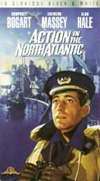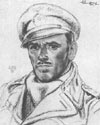An Interview with U-571's director, Jonathan Mostow
byRandy Williams
With sophisticated movie audiences coming to expect seamless high tech special effects, historical accuracy, and authenticity for films set within a time period of documented history, like "Saving Private Ryan, and "The Thin Red Line", the filmmakers of "U-571" knew they had their work cut our for them. The movie is a fictional WWII seafaring tale about a U.S. Navy submarine crew assigned to confiscate a decoding device from a stranded German U-boat.
Writer/director Jonathan Mostow and producer Martha DeLaurentiis depended on a core group of real life World War II veterans to help them capture the look, feel, and crew portrayal of submarine life and sea warfare. The creative team was well aware from the beginning that a boat movie would be "dead in the water" if they couldn't pass the viewers' authenticity test whose standard was raised significantly by James Cameron's "Titanic". "We surrounded ourselves with retired WWII submariners- German, British, and American, to ensure the technical accuracy of the film, "states Mostow, "These veterans were on the set during every minute of shooting to verify the authenticity of the action."
The primary technical advisor was retired American Vice Admiral Patrick Hannifin. Shot primarily at the Cinecitta Studios in Rome, Italy and the Mediterranean Film Studios (MFS) in Malta, Hannifin was ever present for the 100 day + shoot. His background was ideal for the film. His first assignment was as an ensign aboard the American "S-33" submarine. Also for the first eight months after the war he was the chief officer aboard a captured German U-boat! Hannifin spent a lot of time learning how it operated and figuring out its systems. "Patrick was ideal for us, " says Mostow, "With his hands-on experience on both German and American subs, he provided us with an excellent first hand account of what these boats were like."
"The Vice Admiral devised for us a curriculum that became essentially a submarine school for the actors," reveals "U-571" producer, Martha DeLaurentiis, "We made the actors learn both in the classroom and on the set." This group, which included Matthew McConaughey, Bill Paxton, and Harvey Keitel, became immersed in ballast systems, propulsion systems, station-by-station operations, and an overall understanding of operating and maneuvering the sub.
In creating the film, the writer/director had a firm viewpoint on the performers' grasp of their roles. "It was my strong belief that if the actors truly had a real understanding of submarining and the technology behind it and not just a case of pulling down the red handle or merely reading a gauge but rather they knew what that handle was for that it would enhance their performances. I believe it did, "states Mostow.
For historical aspects of the Battle of the Atlantic and elements of the enigma machine, the filmmakers turned to historian Dr. David Kahn and retired Lt. Commander David Balme of the British Royal Navy. "We consulted with Dr. Kahn, who has written several books on the subject and is considered pretty much the world's expert on the enigma," reveals the director, " Basically we wanted to ensure the way I depicted the machine was correct. He understood it was a movie and not a history lesson. To make a two hour movie solely about codebreaking you have a very boring training documentary. Nobody would watch that. Dr. Kahn helped me transform these elements into a way that a mass audience could understand and be informed in an entertaining way."
David Balme, like Hannifin, was an excellent source of first hand information. Balme was in fact the officer who captured the first enigma machine from a German U-boat. On May 9, 1941 he was engaged in a naval action in which his destroyer forced U-110 to the surface. The standard procedure was to ram the U-boat so that the crew could not get up on deck and start firing their guns. The British commander however noticed the German crewmembers just fleeing off the boat as fast as they could. He decided to send a boarding party and secure all intelligence materials they could find. That party was led by Balme, who took the terrifying trip not knowing if an enemy was lurking in the sub to ambush him or if the boat was booby-trapped. Upon finding the boat empty and removing anything that looked useful, Balme took what he thought was a strange typewriter, having no idea what he brought back was the coveted enigma machine. Its capture proved absolutely crucial to the allied codebreaking efforts headquartered in England at Bletchley Park.
With attention to detail critical in all phases of the film, the creators also had to correctly portray the German side. "We used only German actors to portray Germans, "says DeLaurentiis, "Captain Hans-Joachim Krug was an actual German U-boat commander during WWII and a consultant on our film, adds the producer, " Mr. Krug was recommended by one of our production designers, Gotz Weidner, they had worked together on the film, "Das Boot." Hans was very instrumental for our German side, like Patrick was for the American side, in telling the actors how to portray a crew member, what the protocol was, what the logical sequence of events would have been."
- [Editor's note: Krug was actually first officer on U-219. Due to his experience both in
U-boats and later as a cameraman, he also served as a consultant during the making of Das Boot.]
The filmmakers' commitment to authenticity extended to equipment as well. The film's production designers and art department traveled the world for nearly a year searching naval depots, scrapyards, and private collections for actual parts from German subs. Since reliable German and American subs from that era which are sea worthy don't exist anymore, the design and engineering teams took over a year to build a functional replica. The periscope in the film was a real one found crated in a German warehouse. "We built a replica from scratch using old blueprints from that era," says DeLaurentiis.
Since most of the film was shot in Italy, the filmmakers also consulted with the Italian Navy. "Rear Admiral Tommaso Angelino of the Italian Navy was outstanding," beams the producer, "He basically worked it out where the captain, crew, and destroyer we used in the final sequence were on standing orders to be at our disposal. Their cooperation was very generous." A private Italian collector also loaned the filmmakers a vintage Italian fighter that was modified to appear as a German reconnaissance plane. "For the real aviator buffs, of which I know there are many, we tried hard but could not find a plane that was in flyable condition for filming out over the water," notes Mostow.
American naval Captain Ernest Till advised on story content and Captain Lance Julian, who worked on "Titanic", was the film's marine consultant. He was responsible for the movement of all the boats and crew.
With such a huge production and diversity of age, race, and nationalities of the cast, crew, and advisors chaos could easily have set in on the nearly 4 month shoot. "I believe what kept us all together, " says Mostow, " was the sense that we were paying tribute to a generation of brave men that went before us."
The director adds, "The sad truth is that many young people today have no idea what occurred in WWII, much less the Battle of the Atlantic. It is my sincere hope that people will see "U-571" and be motivated to learn more about the real-life heroes who fought to preserve world freedom."
This article copyright 2000, Randy Williams.





